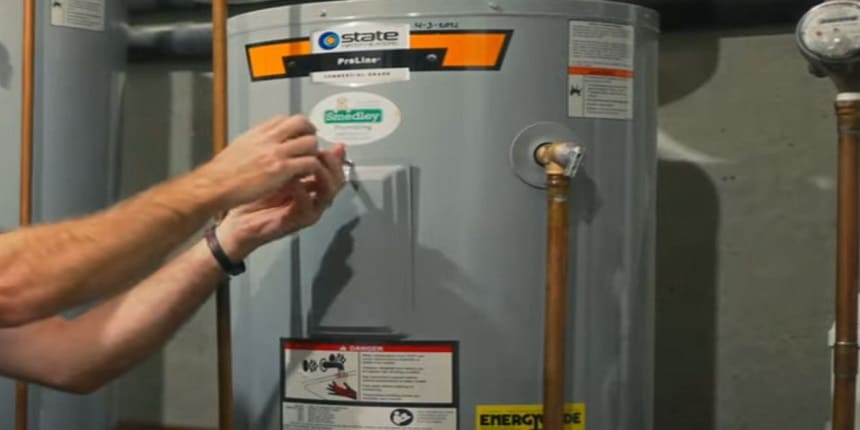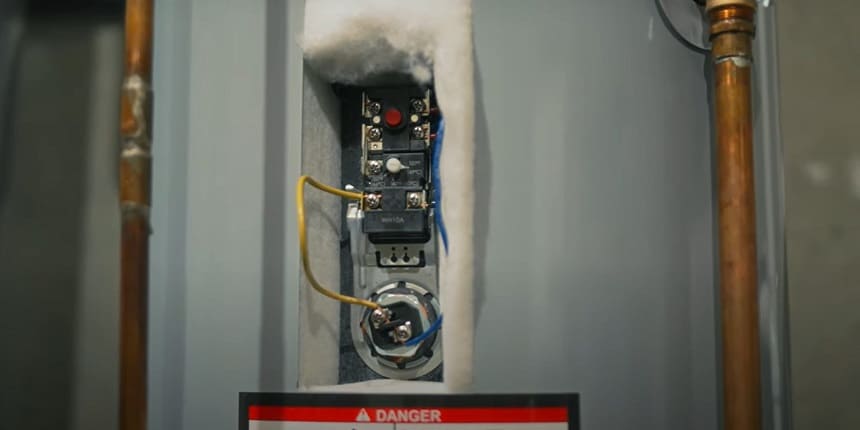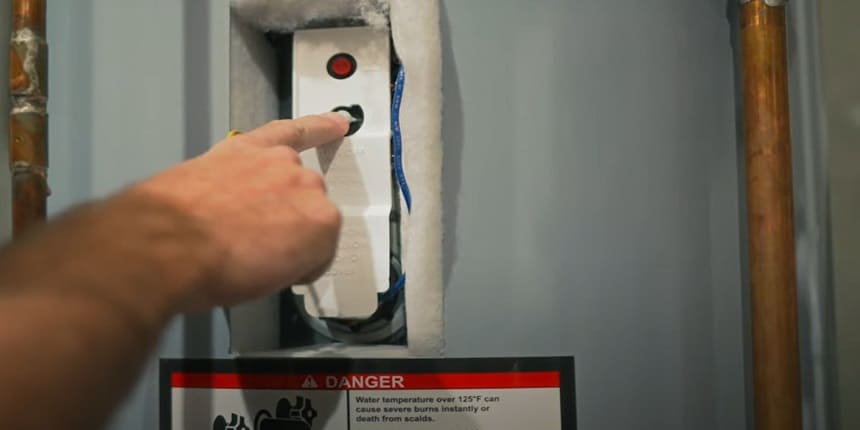Set the water heater thermostat to 120°F for both the top and bottom elements. This temperature balances safety and energy efficiency.
Setting the correct temperature for your water heater is crucial for both safety and efficiency. A water heater thermostat set to 120°F ensures that the water is hot enough to prevent bacterial growth while also reducing the risk of scalding.
This setting also helps in lowering energy bills, as the heater doesn’t need to work as hard to maintain excessively high temperatures.
Page Contents
- 1 Introduction To Water Heater Thermostat Settings
- 2 Dual Thermostat System – adjusting thermostat on water heater
- 3 Assessing Your Hot Water Needs
- 4 Fast, Reliable Water Heater Service
- 5 Safety Considerations
- 6 Energy Efficiency And Cost Savings
- 7 Step-by-step Guide To adjusting hot water heater thermostat
- 8 Troubleshooting Common Issues adjusting temperature on water heater
- 9 Professional Maintenance And When To Seek Help
- 10 Advanced Tips For Optimal Performance
- 11 Frequently Asked Questions
- 12 Conclusion
Introduction To Water Heater Thermostat Settings
Water heaters have two thermostats. One is at the top, and the other is at the bottom. Both thermostats control the water temperature.
The top thermostat heats the upper part of the tank. The bottom thermostat heats the lower part of the tank. Both must be set correctly for efficient heating. Incorrect settings can cause hot water to run out quickly.

Setting the right temperature is crucial. It ensures energy efficiency and safety. Too hot can cause burns. Too cold can lead to bacteria growth. The recommended setting is 120°F. This setting saves energy and prevents scalding.
Dual Thermostat System – adjusting thermostat on water heater
Dual thermostats have two separate controls. The top thermostat handles the upper heating element. The bottom thermostat controls the lower heating element.
Together, they keep water at the desired temperature. The top thermostat activates first, heating water at the top. Once the top reaches the set temperature, the bottom thermostat activates. This ensures hot water is available quickly.
Separate controls offer several benefits. They allow more precise temperature management. Energy consumption is reduced, saving money.
Hot water is available more quickly. Having two thermostats can extend the lifespan of the water heater. If one thermostat fails, the other can still function. This provides a backup, ensuring consistent hot water supply.
Assessing Your Hot Water Needs
Small families use less hot water. Large families need more hot water. Two people use less hot water than four people. Hot water is used for showers, dishes, and laundry. More people means more hot water is needed. Less people means less hot water is used.
Hot water settings change with seasons. Winter needs higher settings. Summer needs lower settings. Cooler weather makes water cooler. Warmer weather makes water warmer. Adjust settings to save energy. Proper settings save money on bills.
Need Local Help?
Fast, Reliable Water Heater Service
Whether it’s installation, repair, or replacement, connect with a trusted local expert today. From fixing leaks and heating issues, we’ve got you covered.
Simply choose your service type in the form, share your details, and a certified water heater specialist will contact you shortly!
Smart Water Source is an informational platform that helps users connect with local plumbers. We do not directly provide plumbing services or operate as a licensed contractor.
Safety Considerations
Setting the water heater temperature too high can cause scalding injuries. It is important to keep the thermostat at 120 degrees Fahrenheit or lower. This temperature is safe for most household tasks. It also helps in preventing accidental burns.
Legionella bacteria can grow in water heaters if the temperature is too low. To avoid this, keep the thermostat at 120 degrees Fahrenheit. This temperature is effective in killing bacteria. It ensures safe water for your family.
Energy Efficiency And Cost Savings
Setting your water heater thermostat can save you money. Many people set it too high. This wastes energy and costs more. Keeping it at 120 degrees Fahrenheit is usually enough.
This setting can save you up to 10% on your bills. Always check the manufacturer’s instructions first. They might have different recommendations.
Finding a good balance is important. You want hot water but not high bills. Lower settings use less energy. This means lower utility bills. Higher settings give hotter water but cost more.
Try setting it lower first. If the water is not hot enough, then increase it a bit.
Thermostat settings greatly impact your utility bills. Higher settings use more energy. This leads to higher bills. Lower settings use less energy. This saves money.
Always check your bills after changing the setting. You will see the difference. Save money and energy by keeping the setting low.
Step-by-step Guide To adjusting hot water heater thermostat

Gather a flat-head screwdriver and a thermometer. These tools help you adjust the thermostats. Ensure you have safety gloves for protection. A flashlight can be useful in dark areas. Having these tools makes the job easier.
Turn off the power to the water heater. Remove the access panel using the screwdriver. Locate the top thermostat behind the panel.
Use the screwdriver to adjust the temperature dial. Set it to your desired temperature. Replace the access panel and restore power. Check the water temperature with the thermometer. Adjust if necessary until it reaches the desired level.
Turn off the power to the water heater again. Remove the lower access panel. Locate the bottom thermostat. Use the screwdriver to adjust the temperature dial.
Set it to the same temperature as the top thermostat. Replace the access panel and restore power. Use the thermometer to check the water temperature. Make further adjustments if needed.
Troubleshooting Common Issues adjusting temperature on water heater
Check the thermostat settings. Make sure both the top and bottom thermostats are set correctly. Adjust the temperature settings to a safe level, around 120°F.
If the water is still too hot, lower the temperature by a few degrees. If the water is too cold, increase the temperature a bit. Wait for a few hours and check again.
First, turn off the power supply to the water heater. Remove the access panel and use a multimeter to test the thermostat. If it is not working, replace it with a new one.
Make sure the wiring connections are secure and there are no loose wires. After replacing, turn the power back on and test the water temperature.
Need a Replacement? Find Right Water Heater Access Panel Here!
Ensure smooth maintenance with new water heater access panels. These panels make it easier to access your water heater’s components, allowing for faster repairs and reducing downtime. Perfect for both professionals and DIYers!
Professional Maintenance And When To Seek Help
Setting the water heater thermostat correctly ensures optimal performance. Top and bottom settings need professional maintenance for safety. Seek help if temperature inconsistencies occur.

Regular Check-ups For Longevity
Regular check-ups keep your water heater working well. Inspect the thermostat settings for any changes. Look for any signs of wear and tear. Check for rust or leaks around the heater.
Ensure there are no strange sounds coming from the heater. These steps help in early detection of problems. A well-maintained heater lasts longer and saves money.
Signs You Need A Professional’s Assistance
Cold water from the heater signals a problem. Strange noises might indicate a serious issue. Rusty water is a red flag for corrosion. Leaks around the heater need immediate attention.
Inconsistent temperatures suggest thermostat issues. Always call a professional if you notice these signs. Experts can fix problems quickly and safely.
Advanced Tips For Optimal Performance
Insulating your water heater can save money. It helps keep the water hot for longer. Use an insulation blanket to cover the heater. Make sure to wrap it tightly.
This reduces heat loss. You can find these blankets at hardware stores. They are easy to install. Just follow the instructions on the package. Doing this can lower your energy bills.
Smart thermostats can make your water heater more efficient. They allow you to control the temperature remotely. Some models can even learn your usage patterns.
This helps in saving energy. Look for smart thermostats with Wi-Fi connectivity. They offer better control and monitoring. Installing one is usually simple. You might need a professional for some models. This upgrade can improve your water heater’s performance significantly.
Frequently Asked Questions
Should Upper And Lower Thermostats Be Set The Same?
Yes, set both upper and lower thermostats the same. This ensures even heating and efficient energy use.
How Do Upper And Lower Thermostats Work On A Water Heater?
Upper and lower thermostats control water heater temperature. The upper thermostat activates the upper heating element first. Once the top is hot, the lower thermostat turns on the lower heating element. This ensures efficient heating.
What Should The Bottom Thermostat Be Set At In A Water Heater?
Set the bottom thermostat of your water heater to 120°F (49°C). This temperature ensures safety and energy efficiency.
Why Are There Two Thermostats On A Hot Water Heater?
Two thermostats on a hot water heater ensure optimal temperature control and energy efficiency by regulating upper and lower heating elements.
Conclusion
Setting the right thermostat temperature for your water heater ensures efficiency and safety. Adjust both top and bottom settings carefully. This helps save energy and maintain consistent water temperature. Regularly check and adjust your thermostat for optimal performance. By following these tips, you can enjoy hot water reliably and efficiently.
